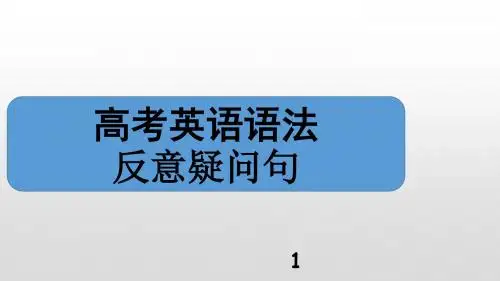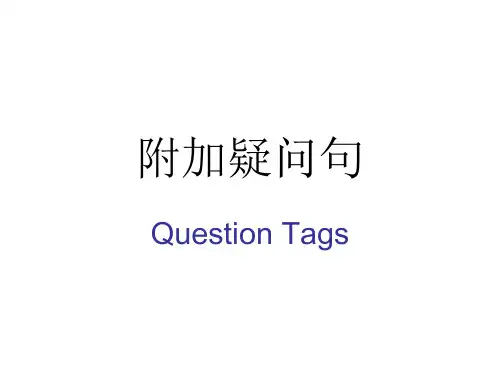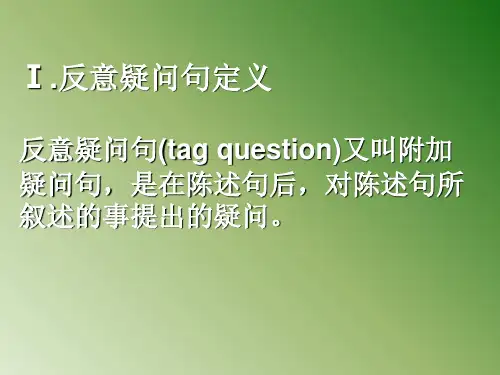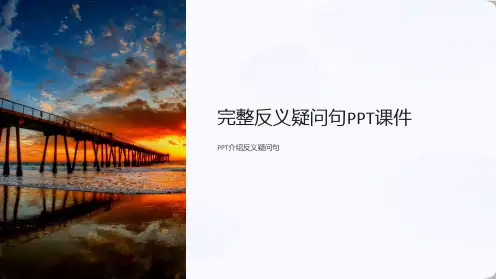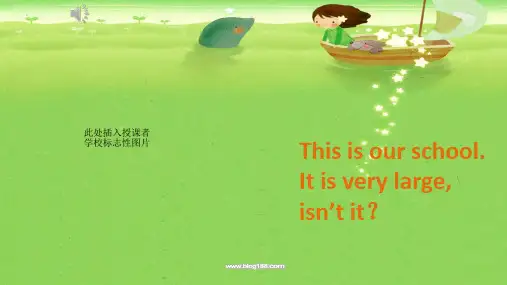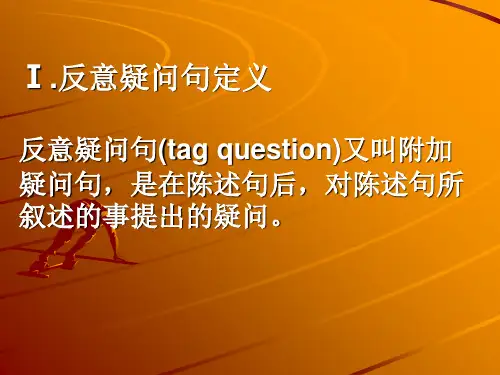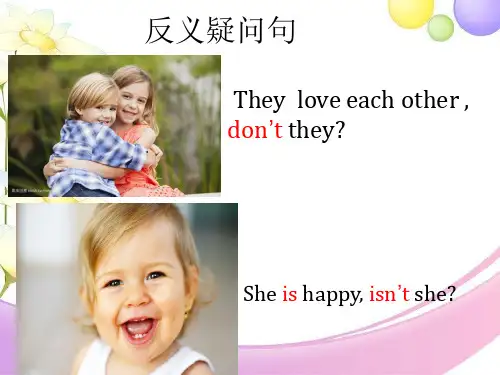- 1、下载文档前请自行甄别文档内容的完整性,平台不提供额外的编辑、内容补充、找答案等附加服务。
- 2、"仅部分预览"的文档,不可在线预览部分如存在完整性等问题,可反馈申请退款(可完整预览的文档不适用该条件!)。
- 3、如文档侵犯您的权益,请联系客服反馈,我们会尽快为您处理(人工客服工作时间:9:00-18:30)。
4
—、一些特殊结构的反义疑问句:
1.含有ought to 的反意疑问句,陈述部分是肯定的,疑问 部分用shouldn’t / oughtn’t +主语。 He ought to know what to do, oughtn’t he? / shouldn’t he?
2.陈述部分有have/has to +v. (had to + v.),疑问部分常 用don’t/doesn’t +主语(didn’t +主语)。
反义疑问句
Question Tags
1
附加疑问句
附加疑问句(Question Tags)又叫 反意疑问句。反意疑问句由两部分 组成:前一部分是一个陈述句,后 一部分是一个简短的疑问句,两部 分的人称时态应保持一致。
2
归纳为以下5种情况:
1.一些特殊结构的反意疑问句 2.有情态动词的反意疑问句 3.特殊句型的反意疑问句 4.含从句的主从复合句的反意疑问 句 5.需加注意的反意疑问句
6
二、有情态动词的反义疑问句: 1.陈述部分有must 的疑问句,疑问部分根据实际情况 而定。
A.must表示“应该”,其疑问部分用mustn’t(不应该) You must work hard next term, mustn’t you ? B.must表示“必须”,其疑问部分用needn’t(不必) He must finish the work today, needn’t he? C.陈述部分含情态动词mustn’t,表示禁止时,疑问部分就可 以用must或may You mustn’t stop your car here, must you? /may we?
13
14
Nobody knows about it, do they? (does he?) 12 Everything is ready, isn't it?
4.否定前缀或后缀不能视为否定词,其反意疑问句仍用否 定形式。 It is impossible, isn’t it? He is not unkind to his classmates, is he?
3.陈述部分主语是指示代词或不定代词everything, that, nothing, this, 疑问部分主语用it。陈述部分主语是不定 代词everybody, anyone, somebody, nobody, no one 等,疑问部分常用复数they,有时也用单数he。
Everyone knows the answer, don’t they? (does he?)
10
c. 但若是以 I/we think, believe, expect, suppose, imagine等引导的宾语从句,疑问部分与宾语从句相对 应构成反意疑问句 I don't think he is bright, is he? We believe she can do it better, can't she?
he?
5
4.陈述部分有had better + v. 疑问句部分用hadn’t you? You’d better read it by yourself, hadn’t you?
5.陈述部分是“there be”结构时,疑问部分用there省 略主语代词。 There is something wrong with your watch, isn't there? There will not be any trouble, will there? Note: 当为“ there used to be…”句型时,反意问句用 didn’t there。
8
三、特殊句型的反义疑问句: 省去主语的祈使句的反意疑问句,疑问部分用will you。 Don’t do that again, will you? Go with me, will you / won’t you ? 这里就不符合“前否后肯”的原则,而是“前肯后可肯可 否”
Note : Let‘s 开头的祈使句,后用shall we? Let's go and listen to the music, shall we/shan't we? Let us 开头的祈使句,后用will you? Let us wait for you in the reading-room, will you/won't you?
We have to get there at eight tomorrow, don’t we?
3.陈述部分的谓语是used to 时,疑问部分用didn’t +主
语或 usedn’t +主语。
He used to take pictures ther ,其疑问部分必须与must 后面的主要动词相 呼应 ①对现在动作或存在的情况的推测(don’t +主语) You must know the answer to the exercise, don’t you? ②对过去发生的动作或存在的情况的推测有两种情况:
7
(一)句中陈述部分没有表示过去的时间状语,这时疑问 部分中的动词就用现在完成时。 (haven’t / hasn’t + 主语) You must have told her about it, haven’t you? (二)陈述部分有表示过去的时间状语,疑问部分的动词 就用一般过去时。(didn’t + 主语) She must have read the novel last week, didn’t she?
2.陈述部分用 no, nothing, nobody, never, few, seldom,
hardly, rarely, little等否定含义的词时,疑问部分用肯定
含义。
The man
made no answer, did he?
Some plants
never blown (开花), do they ?
9
四、含从句的并列复合句的反义疑问句: 1.陈述部分为主从复合句或并列复合句 a. 并列复合句疑问部分,谓语动词根据邻近从句的谓语而 定。 Mr. Smith had been to Beijing for several times, and he should have been in China now, shouldn’t he? b. 主从复合句,疑问部分谓语根据主句的谓语而定 He is not the man who gave us a talk, is he? He said he wanted to visit Japan, didn’t he?
Note: 注意否定前移。 I didn’t think she was wrong, was she? 而不能说wasn't she?
11
五、需加注意的反义疑问句: 1.陈述部分的主语是I,疑问部分要用 aren’t I。 I’m as tall as your sister,aren’t I?
3
做题步骤与原则
步骤: 1.判定(判断该用肯定还是否定): 2.找动(找句子的助动词:be用be,情态动词用 情态动词,动词原形do,三单does,过去did,完 成have) 3.换代(将主语换为代词主格形式)
原则:
• 遵循“前肯后否,前否后肯”的原则 • Eg • It is your car, isn’t it? • Mary doesn’t like swimming, does she?
